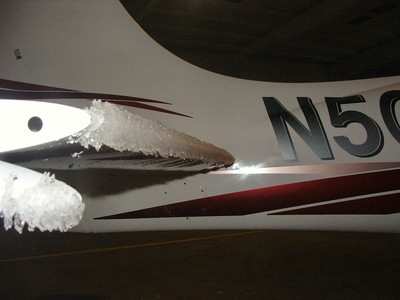Thu, Jan 03, 2008
Ice... Ain't Nice!
For those of us who have "hit the boots" (or the equivalent
system on your favorite bird) a few times in the last few days due
to the ever-present seasonal 'charms' of in-flight icing, we
thought a series of short tips from Cirrus Design's Scott Winter
(yes, that IS his real name) might help us all to consider some of
the realities of this time of year. So... here are the first of
seven tips for dealing with icing. Y'all be careful out there!

Icing Aero-Tip #6: Known Icing Conditions
In a recent letter of interpretation (which is still being
"clarified"), the FAA Eastern Region offered a definition of what
is considered known icing conditions. The letter states that known
icing conditions exist when visible moisture or high relative
humidity combines with temperatures near or below freezing.

It continues to state that since clouds are visible moisture,
flying through them when the temperature is at or below freezing
would constitute flight into known icing conditions. Althought
somewhat ameliorated since then, the letter strictly concludes with
"Flight into known icing conditions when the airplane flight manual
or pilot operating handbook prohibit such flight constitutes a
violation whether the aircraft accretes ice or not."
About Scott Winter
Scott is a member of the Flight Standards Department at Cirrus
Design Corporation in Duluth, MN (one of those places that see more
than its fair share of icing encounters). Born and raised in
Milwaukee, WI, he discovered his passion for aviation at an early
age. After obtaining his Private Pilot Certificate prior to his
senior year in high school, he attended Minnesota State University,
Mankato (MSU) and graduated with a Bachelor's degree majoring in
Professional Flight. In December 2006, he completed his Master's of
Science degree from MSU spending time focusing on aviation weather,
scenario-based training, and visualization techniques to enhance
the methods used to educate aviators.
Note: ANN thanks Cirrus Pilot William Dobson
and other members of the Cirrus community, for the use of the
excellent SR20 icing pix...
More News
Aero Linx: Model Aeronautical Association of Australia MAAA clubs are about fun flying, camaraderie and community. For over 75 years, the MAAA has been Australia’s largest fl>[...]
Touchdown Zone Lighting Two rows of transverse light bars located symmetrically about the runway centerline normally at 100 foot intervals. The basic system extends 3,000 feet alon>[...]
“Discovery and innovation are central to our mission at Virgin Galactic. We’re excited to build on our successful record of facilitating scientific experiments in subor>[...]
How To Get A Story On Aero-TV News/Feature Programming How do I submit a story idea or lead to Aero-TV? If you would like to submit a story idea or lead, please contact Jim Campbel>[...]
Student Pilot Reported That During Rotation, “All Of A Sudden The Back Of The Plane Kicked To The Right..." Analysis: The student pilot reported that during rotation, “>[...]
 ANN's Daily Aero-Linx (05.02.24)
ANN's Daily Aero-Linx (05.02.24) ANN's Daily Aero-Term (05.02.24): Touchdown Zone Lighting
ANN's Daily Aero-Term (05.02.24): Touchdown Zone Lighting Aero-News: Quote of the Day (05.02.24)
Aero-News: Quote of the Day (05.02.24) ANN FAQ: Contributing To Aero-TV
ANN FAQ: Contributing To Aero-TV NTSB Final Report: Cirrus Design Corp SR20
NTSB Final Report: Cirrus Design Corp SR20




